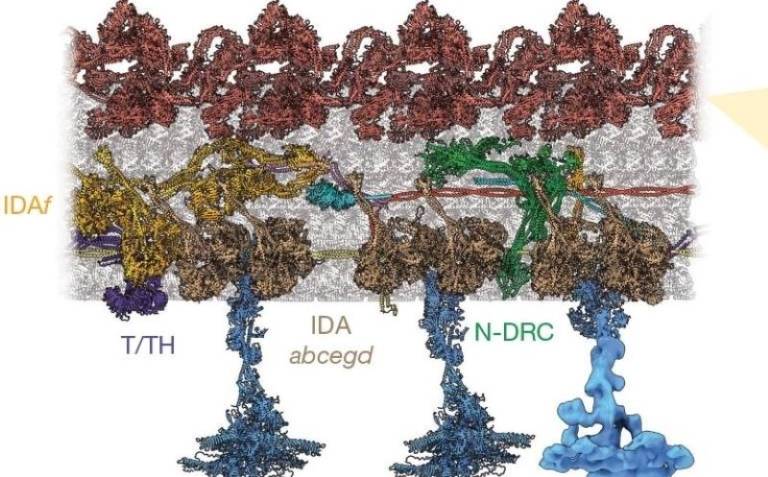World’s first illustration of the molecular machinery that makes cilia beat
13 June 2023
The first image of the structures that power human cilia – the tiny, hairlike projections that line our airways – has been produced by a team involving UCL researchers and could lead to much-needed treatments for people with rare cilial diseases.

The study, published in Nature, combined advanced microscopy and artificial intelligence techniques to create a detailed snapshot of the structure of human cilia. These are the microscopic projections on the cells that line our lungs, ears and sinuses and beat rhythmically to keep the lungs clear from mucus and bacteria. People who inherit the rare condition primary ciliary dyskinesia (PCD) have defective cilia that can’t effectively remove debris from the airways, and so suffer from breathing difficulties and chronic lung infections.
For the first time, the scientists visualised the molecular ‘nano-machinery’ that causes cilia to beat, visible as identical structures dotted every 96 nanometres along the cilia length. These structures come together to form the axoneme. In healthy airways, this complex structure is tightly controlled, with molecules precisely arranged to make cilia beat in a rhythmic, wave-like motion, around a million times a day.
In people with PCD, the team found that cilia don’t beat correctly because key elements of the axoneme structure are missing, caused by genetic mutations. This new information could lead to new medicines that target these defects, making cilia beat properly.
Study co-author, Professor Hannah Mitchison (UCL Great Ormond Street Institute of Child Health), said: “Treatments for PCD currently work to clear people’s airways and prevent infection. Our findings offer the possibility of molecular medicines to precisely target tiny defects in the axoneme and make cilia beat as they should.
“Molecular medicines are showing promise for other rare diseases, and COVID-19 research has unlocked new ways to deliver these drugs directly to the lung. If we can combine these advances with our new findings, my hope is that we’ll bring molecular medicines to people with PCD within the next 5 to 10 years.”
The team’s research could also prove useful for infertility, as sperm cells rely on a similar axoneme structure in their tails to propel themselves forward.
The research team was a global collaboration, with scientists based across the UK, US, Netherlands, China and Egypt. “It can be difficult to study rare diseases like PCD, because patients are spread thinly across the world. In the UK, we think around 9,000 families may be affected by PCD,” said Professor Mitchison. “Our study was made possible by a fantastic international collaboration between clinical scientists, biologists and members of the rare disease community willing to take part in our research.”
In addition to human cilia, the team examined the axoneme structure of a single-celled alga called Chlamydomonas reinhardtii, which uses two tail-like projections on its surface to swim. Despite being separated by more than 1 billion years of evolution, the alga’s tails shared structural similarities with the human airway cilia, highlighting the importance of the axoneme throughout evolution.
This study involved collaborators at Harvard Medical School, Alexandria University, University of Leicester, Amsterdam University Medical Centers, Guy’s and St Thomas’ NHS Foundation Trust and Imperial College London.
At UCL, the study was supported by NIHR Great Ormond Street Hospital Biomedical Research Centre, the Ministry of Higher Education in Egypt and a MRC UCL Confidence in Concept grant.
Links
- Research in Nature
- Professor Hannah Mitchison's academic profile
- UCL Great Ormond Street Institute of Child Health
- UCL Population Health Sciences
Image
- Illustration of human cilia axoneme repeat. Credit: Walton et al
Media contact
Poppy Danby
E: p.danby [at] ucl.ac.uk
 Close
Close

